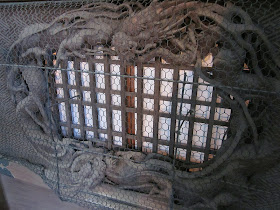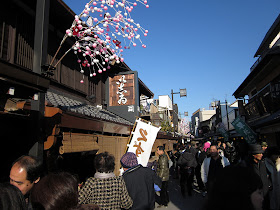While not well known outside of Japan, Shibamata is a great place to go in Tokyo to experience the old Edo culture and atmosphere surviving in the city. Shibamata is a small town in Katsushika City (it's one of Tokyo's 23 wards). Katsushika City is all the way to the northeast of Tokyo, bordering the river of Edogawa. The main station is Shibamata Station.
Shibamata is one of the few areas that still retains the old culture and atmosphere of the Edo Era; in a city known for being modern. These areas are known as Shitamachi. Shitamachi used to refer to a definitive geographical area in Edo, but now is more of a cultural distinction. Two of the geographical descriptions used in Edo during the Edo Era were Yamanote and Shitamachi. Some of you might recognize the word Yamanote from the famous Yamanote train line in Tokyo. These two terms developed during the early Edo Era based on land distribution by the Tokugawa Shogunate that had moved the capital there. The Tokugawas gave land to the leading samurai families at the time in the hillier regions in Tokyo. The merchants and craftsmen lived in the low-lying areas and later areas that were filled in making new land in the city. These two areas came to be known as Yamanote and Shitamachi respectively. Yamanote (山の手) means towards the mountain and Shitamachi (下町) means low city.
While it was as much about a geographical designation as a cultural and status one, over time the class status and cultural designation has become more important. While the cultural and class designation has stayed relatively constant over the years, the geographical areas have changed significantly. Presently, much of Tokyo would actually be considered Yamanote and only a few pockets of Tokyo would still be considered Shitamachi. The class and cultural distinctions are still very much in place and known by people in Tokyo and throughout Japan. Yamanote infers a higher social class and Shitamachi the lower class. While during the Edo Era, the higher class were the military elite, in the present they have come to represent the white collar worker in Japan. Shitamachi used to be the merchant or craftsmen in the Edo days, but is now small shop owners, restaurant owners and local craftsmen. In another way, the Yamanote / Shitamachi distinction represents one of the major divisions in Japan now. Yamanote refers to the modern and future elements of Japan, while Shitamachi refers to the traditional and past of Japan.
While the Shitamachi shrunk in area and cultural importance for many years as Japan was pushing forth the ideas of modern and future technologies for economic growth, Shitamachi has more recently regained cultural importance in Japan. A desire to keep, preserve and celebrate Japan's traditional culture has made Shitamachi popular again as it is seen to be the true traditional parts of Tokyo and Japan. Much of the popularity in Shibamata, is that it is one of these centers of Shitamachi culture. You can see it from the main shopping street in Shibamata with the street lined with the old style small shops on both sides.
 |
| The start of the shopping street after getting out of the station. |
Also right outside of the station is a statue of Shibamata's other claim to fame.
This is the statue of Tora-san. Mr. Tora was the main character for a series of movies called 'Otoko wa Tsuraiyo' (男は辛いよ), meaning, 'It's Tough Being a Man.' The movies were made from 1969-1995 and total 48 in all, ending due to the death of the main actor. The main character was from Shibamata, but in the movies he is a traveling salesman. Also, one of the small shops on the street was used in the early films and is called Tora-ya which means Tora's shop.
 |
| Beginning the walk down the main shopping street. The New Year's decorations are still out (that's what the pink and white balls on wire are). |
 |
| This building is actually a very old candy shop, still like one might see 20, 30 or even 50 years ago. The picture is mainly of the Sci-fi decorations on the building. |
 |
| Another of the traditional shops. |
While this is a shopping street, Shibamata actually has a destination for its shopping street. Towards the end of the shopping street, the destination looms in the distance.
At the end of the shopping street looms Shibamata Taishakuten, Shibamata's famous temple. This temple has stood at this spot since 1629, when it was previously Kyoei-zan Daikyoji. It is a Nichiren Buddhist temple. Taishakuten (帝釈天) is the Japanese Buddhist version of the Hindu god Indra. [1] Not to go too far into Hinduism, but I'll provide a little explanation about Indra and why it would happen to show up at a Japanese Buddhist temple. Indra is the king of the Devas or Hinduism's Gods. Indra is the god of war, storms and rain. As for why it is at a Buddhist temple in Japan, Indra is also included in Buddhism, where he and Brahma are the protectors of the Buddha. Indra is thus seen as a protector in Japanese Buddhism. Shibamata's Taishakuten is specifically believed to protect against illness, fire or other disasters and a destroyer of evil. [2]
The temple contains a wooden figure of Taishakuten (Indra), that was originally carved by Nichiren (the 9th century founder of this sect of Buddhism). [3] This important artifact was somehow lost during the late Heian or Muromachi Periods (1175-1573). However it was rediscovered centuries later, in 1779 when the head priest of the temple had decided to renovate the main prayer hall due to its terrible condition and just happened to find it in the attic. Although they couldn't figure out it was the lost main image until they poured water over it, because of the dust it had collected over the centuries. [4]
The description of the main image of Taishakuten is as follows, "On one side of the main figure is caved [carved sic] the "Hail the Wonderful Lotus Sutra", and on each side is carved a quotation from the chapter on the Medicine-King from the Lotus Sutra which reads, "This sutra is the medicine for all the ill people in the world. Should there be one who is sick and he or she should listen to this sutra, then they will be instantly cured and be free from the fetters of aging and death." And on the other side of the main figure is carved the figure of Taishakuten in a pose of anger with the right hand wielding a sword and the left palm open." [5]
This temple has some incredible architecture, but the best part is its wooden carvings that are incredible works of art.
 |
| A closer view of the Nitenmon (二天門) Gate (you can see its name posted on the sign). |
Nitenmon was made in 1897 and is the main gate to the temple complex. Going through this gate gives a small taste of the incredible woodwork that is to be found inside the temple grounds.
 |
| The detail of the carvings on the left pillar of Nitenmon. |
 |
| A detail above the entrance way of Nitenmon. |
Getting past the shopping street, the whole temple complex comes into view, no longer obscured by the shops.
The building left of Nitenmon is the temple's bell tower. This bell tower was built in 1955.
Once inside, the first large building near the main gate is the main hall. This would be the same main hall as in the story of the miraculous find of the main image after being lost for centuries in 1779. However, by the beginning of the Meiji Period (1868-1912), the main hall would again be in disrepair and had to be rebuilt in 1889.
In front of the main hall is a famous tree called Zui-ryu-matsu.
 |
| This tree is famous for its long branches aided by support beams. It has two branches that are at least 20-30 feet long. |
 |
| The decorations around the tree mark its sacredness. |
 |
| Some more detail of the exterior of the main hall. |
Further inside the temple complex is a nice garden. The garden is called Sui-kei-en and was redesigned in 1965.
 |
| It wouldn't be a Japanese garden pond without some koi (鯉). |
 |
| The monkey in the garden here might be because monkeys are believed to be gods of Taishakuten. [6] |
The garden walkway connects to the main walkway. This walkway connects the main hall, the garden and the incredible Taishaku-do. The Taishaku-do is the building that holds the main image of the temple, the wooden carving of Taishakuten. This building also contains the most incredible wood carving of the whole temple complex by far, as the entire exterior walls of the building are covered in ornate carvings depicting the lotus sutra.
 |
| One of the windows to the main hall. |
The Taishaku-do is such an incredible building that it deserves its own post. So I will continue with the wood carvings of the Taishaku-do next time.
References:
1. Lisa Jardine, "Shibamata: Where History and Movies Collide in Suburban Tokyo," Japan Today.
http://www.japantoday.com/category/travel/view/shibamata-where-history-and-movies-collide-in-suburban-tokyo.
2. "About Shibamata Taishakuten," Taishakuten-Daikyoji.
http://www.taishakuten.or.jp/index2.html.
3. Ibid.
4. Ibid.
5. Ibid.
6. Hajime Ishida, "About Shitamachi," Japan Through Young Eyes.
http://www.shejapan.com/jtyeholder/jtye/young/shitamachi/e2_shitamachi.html.























No comments:
Post a Comment